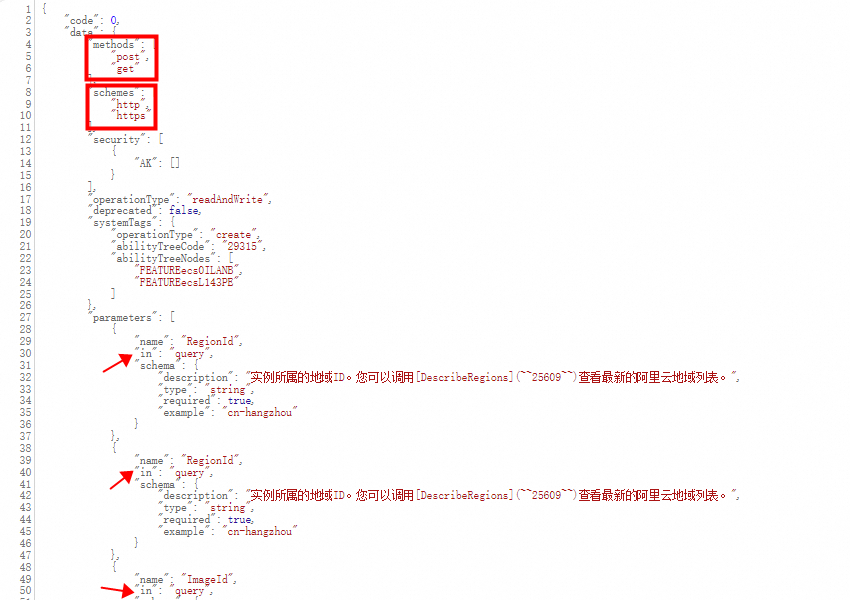泛化調用
阿里云SDK不僅支持使用云產品SDK提供的特化調用方式調用OpenAPI,還支持使用核心SDK提供的泛化調用方式調用OpenAPI,兩種方式的不同請參見泛化調用與特化調用。本文將從獲取API信息、安裝SDK和代碼示例來為您介紹如何使用泛化調用。
獲取API信息
訪問API文檔選擇云產品,例如選擇云服務器ECS。
單擊云服務器名稱下面的獲取元數據,在元數據中
info.style查看云產品支持的OpenAPI風格(RPC或者ROA)。
 說明
說明該位置獲取的元數據中包含了云產品的所有API信息,如果您想要查看單個API的元數據,請查看步驟2。
選擇將要調用的API,單擊右上角獲取元數據。

在元數據中,定義了API支持的網絡協議、請求方式、參數及參數位置等信息。如下圖所示的RunInstances元數據中:
支持的網絡協議有HTTP和HTTPS,建議使用HTTPS。
支持的請求方式有GET和POST,兩者請求方式調用結果無任何差異,但GET請求只支持 32 KB 以內的請求包,所以推薦使用POST請求。
支持的參數有RegionId、ImageId等,參數位置在query,表示參數是要拼接在請求URL后面,例如https://ecs.cn-beijing.aliyuncs.com/?ImageId=aliyun_2_1903_x64_20G_alibase_20231221.vhd&InstanceChargeType=PostPaid&InstanceType=ecs.e-c1m1.large&InternetChargeType=PayByTraffic&MinAmount=1&Password=test%401234&RegionId=cn-beijing&SecurityGroupId=sg-2zec0dm6qi66XXXXXXXX&SystemDisk.Category=cloud_essd&SystemDisk.Size=40&VSwitchId=vsw-2ze3aagwn397gXXXXXXXX。
 說明
說明元數據中其他支持的內容對簽名無影響,這里暫不詳細說明。更多元數據的信息,請參見元數據使用指南。
安裝SDK
在Terminal中執行以下命令安裝核心SDK。
go get github.com/alibabacloud-go/darabonba-openapi/v2/client
代碼示例
示例:調用RPC風格的API
以調用ECS的DescribeRegions接口為例,展示如何使用泛化調用方式。
package main
import (
"fmt"
"os"
openapi "github.com/alibabacloud-go/darabonba-openapi/v2/client"
openapiutil "github.com/alibabacloud-go/openapi-util/service"
util "github.com/alibabacloud-go/tea-utils/v2/service"
"github.com/alibabacloud-go/tea/tea"
)
func main() {
// 從環境變量中獲取訪問密鑰ID和密鑰Secret
config := &openapi.Config{
AccessKeyId: tea.String(os.Getenv("ALIBABA_CLOUD_ACCESS_KEY_ID")),
AccessKeySecret: tea.String(os.Getenv("ALIBABA_CLOUD_ACCESS_KEY_SECRET")),
}
// 設置客戶端的服務接入點
config.Endpoint = tea.String("ecs-cn-hangzhou.aliyuncs.com")
// 初始化并返回客戶端實例
client, err := openapi.NewClient(config)
if err != nil {
panic(err)
}
params := &openapi.Params{
// 設置API的行動、版本和其他必要參數
Action: tea.String("DescribeRegions"),
Version: tea.String("2014-05-26"),
Protocol: tea.String("HTTPS"),
Method: tea.String("POST"),
AuthType: tea.String("AK"),
Style: tea.String("RPC"),
Pathname: tea.String("/"),
ReqBodyType: tea.String("json"),
BodyType: tea.String("json"),
}
// 設置查詢參數
query := map[string]interface{}{
"InstanceChargeType": tea.String("PostPaid"),
}
// 設置運行時選項
runtime := &util.RuntimeOptions{}
// 創建API請求并設置參數
request := &openapi.OpenApiRequest{
Query: openapiutil.Query(query),
}
// 調用API并處理返回結果
response, err := client.CallApi(params, request, runtime)
if err != nil {
panic(err)
}
// 返回值為Map類型,可從Map中獲得三類數據:body、headers、HTTP返回的狀態碼 statusCode。
fmt.Println(response["body"])
}
示例:調用RESTful(ROA)風格的API
以調用容器服務查詢集群列表信息為例,展示如何使用泛化調用。
package main
import (
"fmt"
"os"
openapi "github.com/alibabacloud-go/darabonba-openapi/v2/client"
openapiutil "github.com/alibabacloud-go/openapi-util/service"
util "github.com/alibabacloud-go/tea-utils/v2/service"
"github.com/alibabacloud-go/tea/tea"
)
func main() {
// 從環境變量中獲取訪問密鑰ID和密鑰Secret
config := &openapi.Config{
AccessKeyId: tea.String(os.Getenv("ALIBABA_CLOUD_ACCESS_KEY_ID")),
AccessKeySecret: tea.String(os.Getenv("ALIBABA_CLOUD_ACCESS_KEY_SECRET")),
}
// Endpoint 請參考 https://api.aliyun.com/product/CS
config.Endpoint = tea.String("cs.cn-qingdao.aliyuncs.com")
client, err := openapi.NewClient(config)
if err != nil {
panic(err)
}
params := &openapi.Params{
// 接口名稱
Action: tea.String("DescribeClustersV1"),
// 接口版本
Version: tea.String("2015-12-15"),
// 接口協議
Protocol: tea.String("HTTPS"),
// 接口 HTTP 方法
Method: tea.String("GET"),
AuthType: tea.String("AK"),
Style: tea.String("ROA"),
// 接口 PATH
Pathname: tea.String("/api/v1/clusters"),
// 接口請求體內容格式
ReqBodyType: tea.String("json"),
// 接口響應體內容格式
BodyType: tea.String("json"),
}
// 設置查詢參數
queries := map[string]interface{}{}
queries["name"] = tea.String("cluster-demo")
request := &openapi.OpenApiRequest{
Query: openapiutil.Query(queries),
}
// runtime options
runtime := &util.RuntimeOptions{}
// 返回值為 Map 類型,可從 Map 中獲得三類數據:響應體 body、響應頭 headers、HTTP 返回的狀態碼 statusCode。
response, err := client.CallApi(params, request, runtime)
if err != nil {
panic(err)
}
fmt.Println(response["body"])
}